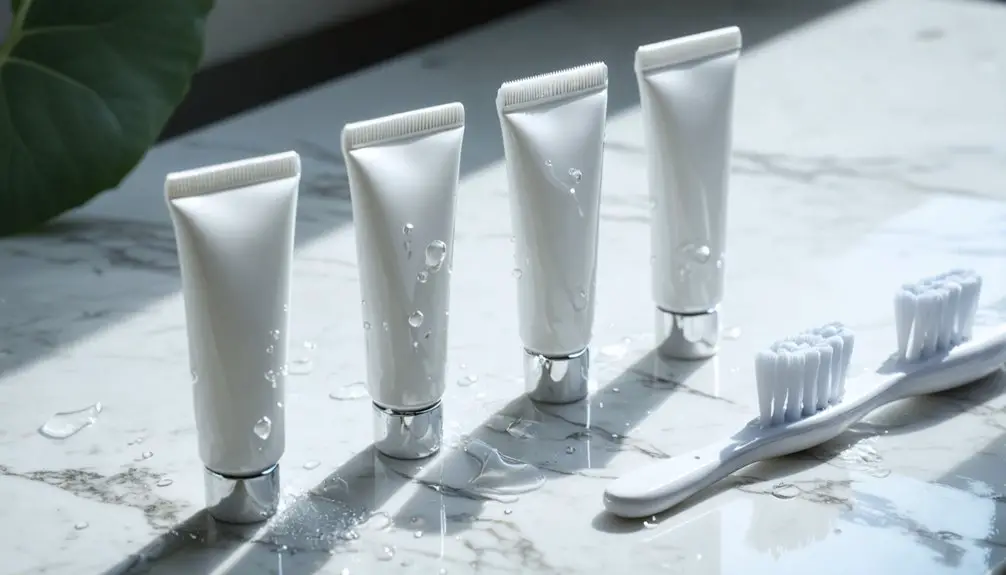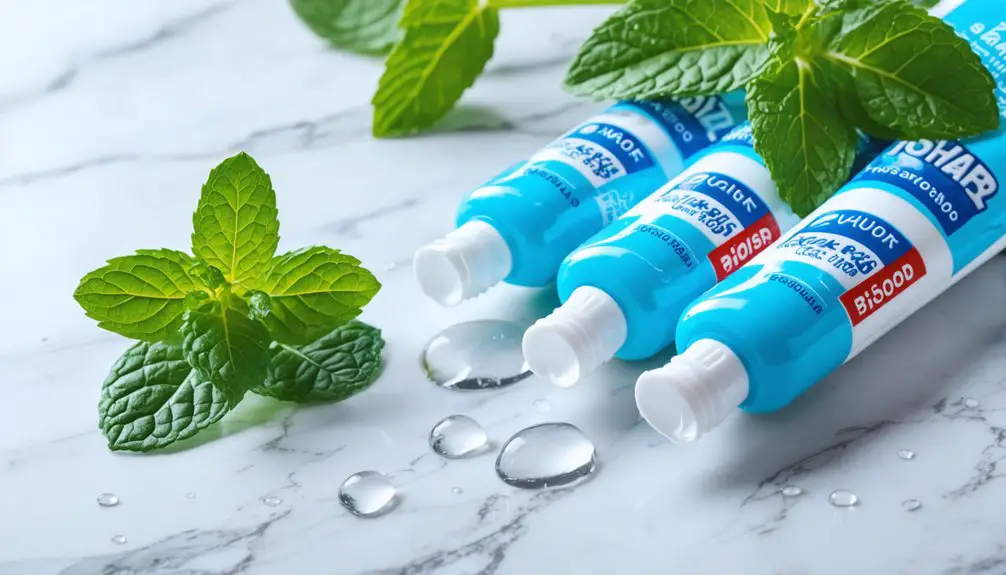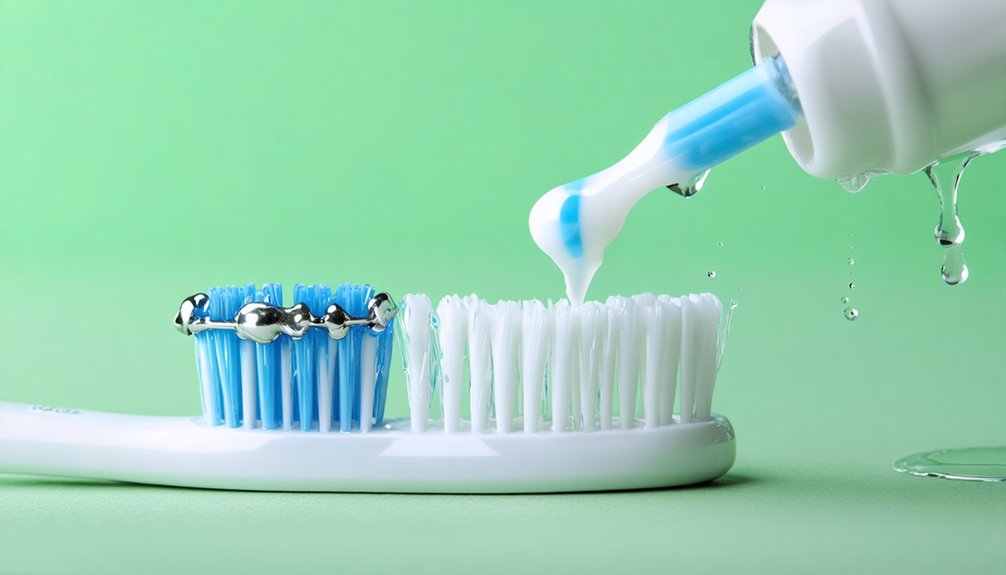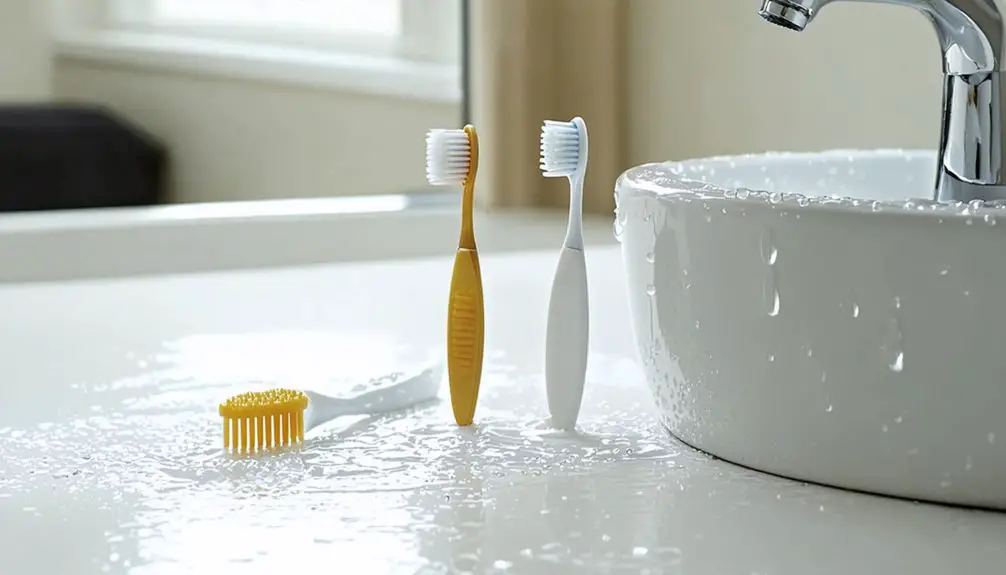For sensitive gums and whitening needs, you’ll find best possible results with Sensodyne Clinical White, offering two shades of whitening in two weeks while protecting against sensitivity. Colgate Optic White Renewal uses concentrated hydrogen peroxide for deep stain removal, while Boka Ela Mint employs nano-hydroxyapatite for natural repair. Crest 3D White Brilliance and Tom’s of Maine round out your top options, each delivering gentle yet effective whitening. Understanding your specific sensitivity level will guide you toward your ideal formula.
Key Takeaways
- Sensodyne Clinical White provides two shades of whitening within two weeks while offering 24-hour sensitivity protection for gums.
- Colgate Optic White Renewal uses concentrated hydrogen peroxide for deep stain removal without irritating sensitive gums.
- Boka Ela Mint utilizes nano-hydroxyapatite technology to naturally repair enamel and whiten teeth while being gentle on gums.
- Crest 3D White Brilliance features an enamel-safe formula that removes stains effectively while remaining gentle on sensitive gums.
- Tom’s of Maine offers natural whitening alternatives that are less likely to irritate gums while still providing effective whitening results.
Understanding Sensitive Gums and Whitening Needs
When gum sensitivity strikes, understanding its root causes and relationship to oral health becomes essential for effective treatment.
You’ll notice symptoms like soreness during brushing, swollen or bleeding gums, and persistent bad breath, which often indicate underlying gingivitis. These issues can complicate your desire for whitening treatments, as sensitive gums require special consideration.
Your gum health may be compromised by various factors, including plaque buildup, hormonal changes, or systemic conditions like diabetes. Poor dental hygiene significantly contributes to gum sensitivity and plaque accumulation.
Regular dental checkups help identify pocket depths exceeding 3mm, indicating potential gum disease that could affect whitening effectiveness. Nearly half of adults over age 30 develop some form of periodontal disease.
If you smoke, you’re at considerably higher risk for gum sensitivity and reduced treatment outcomes.
Understanding these factors helps you choose appropriate toothpaste that addresses both sensitivity and whitening needs without exacerbating gum inflammation.
Key Features to Look for in Sensitivity-Friendly Whitening Toothpaste
Since protecting sensitive gums requires careful consideration of toothpaste ingredients, you’ll need to focus on specific features that address both sensitivity and whitening needs.
Look for formulas containing stannous fluoride that create a protective barrier while incorporating gentle whitening agents that won’t trigger sensitivity or gum irritation. With a 4.6 star rating, Sensodyne Sensitivity & Gum Whitening Toothpaste demonstrates strong effectiveness for these needs. Users report experiencing notable improvement within just three days of regular use.
Choose toothpastes with low-abrasion formulas that safely remove surface stains without compromising enamel health. The ideal product should offer triple-action benefits: whitening, polishing, and protection.
Verify it contains antimicrobial properties to combat plaque bacteria linked to gingivitis while supporting overall gum health.
For best results, select toothpastes featuring mild mint flavoring and recyclable packaging, and maintain a twice-daily brushing routine for two minutes each session.
Top Recommended Products for Sensitive Gums and Whitening
Several leading toothpaste brands have developed specialized formulations that effectively address both gum sensitivity and whitening needs.
When selecting a toothpaste that combines these benefits, you’ll find various whitening methods integrated with sensitivity-reducing ingredients. Low-abrasive formulas with potassium nitrate help block nerve sensitivity while still removing surface stains. For optimal results, daily flossing should complement your whitening toothpaste routine.
- Sensodyne Clinical White delivers two shades of whitening within two weeks while maintaining 24-hour sensitivity protection.
- Colgate Optic White Renewal uses concentrated hydrogen peroxide for deep stain removal without compromising sensitive gums.
- Boka Ela Mint employs nano-hydroxyapatite technology for natural enamel repair while gently whitening.
- Crest 3D White Brilliance offers advanced stain removal with an enamel-safe formula that’s gentle on sensitive gums.
Choose these toothpaste brands based on your specific sensitivity level and desired whitening results, as each formulation provides unique benefits for your oral care needs.
Natural vs. Clinical Formulations: Which Works Better?
Many consumers face an essential decision between natural and clinical toothpaste formulations for treating sensitive gums.
While chemical formulations with peroxide compounds deliver faster whitening results, they can cause enamel roughening and increased sensitivity.
Natural ingredients like nano-hydroxyapatite offer a gentler approach, promoting enamel remineralization and reducing sensitivity by blocking dentinal tubules.
Products like Tom’s of Maine provide effective natural alternatives without compromising on whitening capability.
Regular professional cleanings are crucial for maintaining both whitening results and gum health.
You’ll find that natural formulations typically require longer-term use to achieve comparable whitening effects, but they’re less likely to irritate sensitive gums and teeth.
They work through mild abrasives and biocompatible components that support tooth repair.
If you’re treating patients with sensitivity concerns, natural toothpastes containing nano-hydroxyapatite can provide effective whitening while actively reducing discomfort – a benefit rarely achieved with peroxide-based products.
Expert Tips for Using Whitening Toothpaste With Sensitive Gums
While achieving a brighter smile remains a common goal, using whitening toothpaste with sensitive gums requires careful preparation and technique to minimize discomfort. Professional cleaning can effectively remove surface stains without causing additional sensitivity.
If you’re dealing with tooth sensitivity and whitening concerns, following expert recommendations can help protect your oral health while pursuing teeth whitening. Using a soft-bristled toothbrush is essential for preventing further irritation during whitening treatments.
- Start using sensitive toothpaste with desensitizing agents like potassium nitrate at least 2 weeks before whitening.
- Choose ADA-approved whitening products with mild abrasives and low peroxide concentrations (5-10%).
- Alternate between whitening and sensitive toothpaste formulations to reduce gum irritation.
- Avoid cold foods and acidic beverages during whitening treatment, and rinse with lukewarm water after brushing.
If sensitivity persists beyond a few days, consult your dentist to explore gentler whitening alternatives suited to your needs.
Frequently Asked Questions
How Long Should I Wait After Eating Before Using Whitening Toothpaste?
You’ll need to wait 30 minutes after eating and rinse your mouth before using whitening toothpaste. Following these best practices helps protect your enamel and supports healthy eating habits.
Can I Use Whitening Toothpaste While Wearing Braces or Dental Veneers?
You can use whitening toothpaste with braces or veneers, but you’ll need to be cautious. Choose non-abrasive formulas for braces care and safety, and consult your orthodontist first to prevent damage.
Will Whitening Toothpaste Affect the Color of Dental Crowns or Fillings?
Whitening ingredients won’t change your dental restorations’ color. Your crowns and fillings will maintain their original shade while natural teeth may lighten, potentially creating a noticeable color difference between them.
Should I Brush Longer When Using Whitening Toothpaste for Sensitive Gums?
No, don’t extend your brushing time. You’ll risk increasing gum sensitivity with prolonged exposure to whitening agents. Stick to gentle brushing techniques for two minutes to protect your sensitive gums.
Is It Safe to Use Whitening Toothpaste During Pregnancy?
While over-the-counter whitening toothpaste is generally considered safe, you’ll want to prioritize pregnancy precautions. Consult your healthcare provider, as whitening safety during pregnancy hasn’t been extensively studied.
References
- https://www.tribecasmiles.com/top-whitening-toothpastes-for-sensitive-teeth-2025
- https://myprivatedentist.com/best-toothpaste-for-sensitive-teeth/
- https://nhdentistrybeverlyhills.com/press/the-5-best-whitening-toothpastes-according-to-a-cosmetic-dentist/
- https://www.cnet.com/health/personal-care/best-whitening-toothpaste/
- https://www.kirklanddentalexcellence.com/blog/health/best-toothpaste-for-teeth-whitening/
- https://www.healthline.com/health/sensitive-gums
- https://www.ftbenddental.com/blog/sensitive-gums-when-to-see-your-dentist/
- https://www.mayoclinic.org/diseases-conditions/gingivitis/symptoms-causes/syc-20354453
- https://www.nidcr.nih.gov/health-info/gum-disease
- https://www.dhconcepts.com/getting-to-the-root-of-teeth-gum-sensitivity/



